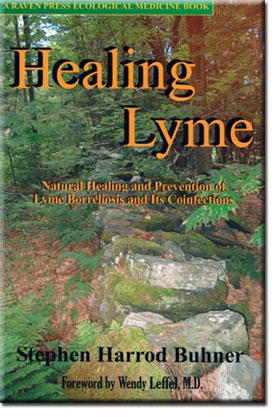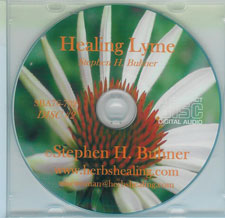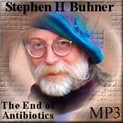The Environmental Impacts of Technological Medicine
By Stephen Harrod Buhner
Excerpt from The Lost Language of Plants
The Ecological Importance of Plant Medicines to Life on Earth
In their drive to conquer disease, the supporters of technological medicine have created a great many industrial products: pharmaceuticals; personal care products (things like sunscreens and antibiotic soaps); radiopharmaceuticals and chemotherapy;  and pharmaceutical delivery and medical practice products (things like hypodermic needles, latex gloves, thermometers). All of them end up in the environment. All of them have significant impacts.
and pharmaceutical delivery and medical practice products (things like hypodermic needles, latex gloves, thermometers). All of them end up in the environment. All of them have significant impacts.
Pharmaceutical Drugs
The vast majority of pharmaceutical drugs do not heal diseases—they control symptoms by introducing chemical mediators, at specific levels, into the body. People with high blood pressure, for example, are not cured when they take medication, which is why they have to take it regularly, often for the rest of their life.
Unlike plants, blood pressure medications, and nearly all pharmaceuticals, are not a normal part of the diet nor a food previously encountered in our evolution. So, the human body excretes them throughout the day in urine and feces: 50-95 percent of each drug taken is excreted chemically unchanged or unmetabolized.1 As blood pressure medication is excreted blood pressure begins to rise and more of the drug must be taken.
Drugs used for acute conditions, such as antibiotics, are usually taken short term; those used for chronic conditions like high blood pressure are usually taken for years or an entire lifetime. In consequence, enormous quantities of pharmaceuticals are going through people’s bodies into the environment, where they are proving to have powerfully negative impacts in ecosystems. And the quantity of drugs and other biologically active medical products that are flowing into the environment is increasing every day.
A recent New York Times article observed that: “Prescription drugs are now the fastest-growing part of the nation’s health care bill. That is not so much because manufacturers are raising prices for existing drugs, but because patients are switching to newly approved medicines that cost more, and more prescriptions are being written than ever before.”2 Retail prescription sales for pharmaceuticals were $42.7 billion in 1991. In 1999, a mere eight years later, sales were $111.3 billion.3 In the next decade, as the knowledge from the unraveling of the human genome makes even more drugs possible, this figure is expected to increase substantially.
At present there are some 500 known chemical receptor sites in the human body affected by drugs. With information from the human genome project this number is expected to soar to between 3,000 and 10,000 sites. As Dr. Gillian Woolett of the Pharmaceutical Research and Manufacturers Association excitedly proclaimed, “The rate of change is absolutely incredible.”4 The two scientists who have done the most research on pharmaceuticals in the environment, Christian Daughton (of the U.S. Environmental Protection Agency—EPA) and Thomas Ternes (of the Institute of Water Research and Water Technology in Weisbaden, Germany), comment that “[This] escalating introduction to the marketplace of new pharmaceuticals is adding exponentially to the already large array of chemical classes, each with distinct modes of biochemical action, many of which are poorly understood.”5
Many excreted pharmaceuticals and their metabolites are not biodegradable and go on producing chemical effects forever. Most that do biodegrade are regularly replenished by the need for continual dosing or by new prescriptions for new people.  As pharmaceuticals are excreted in pure and metabolized forms they also intermix in the waste streams that flow into the environment in ways that cannot be predicted, with effects that are not understood. Researchers have found that metabolites, chemicals produced as byproducts of pharmaceutical interaction with the body, tend to be more persistent in the environment, and are sometimes more powerful in their actions, than the drugs from which they are derived.6
As pharmaceuticals are excreted in pure and metabolized forms they also intermix in the waste streams that flow into the environment in ways that cannot be predicted, with effects that are not understood. Researchers have found that metabolites, chemicals produced as byproducts of pharmaceutical interaction with the body, tend to be more persistent in the environment, and are sometimes more powerful in their actions, than the drugs from which they are derived.6
In 1999 Americans filled 2.8 billion prescriptions covering roughly sixty-six classes of pharmaceuticals. These include: antidepressants, tranquilizers and psychiatric drugs; cancer (chemotherapy) drugs; pain killers; anti-inflammatories; antihypertensives; antiseptics; fungicides; anti-epileptics; bronchodilators; lipid regulators (e.g., high-cholesterol medication); muscle relaxants; oral contraceptives; anorectics (diet medication); synthetic hormones; and antibiotics.7
These pharmaceutical drugs and the personal care products also manufactured by many pharmaceutical companies (such as sunscreen lotions, lipsticks, deodorants, perfumes, and shampoos) are produced in staggeringly huge quantities; often equaling or surpassing agrochemicals in tonnage. The number of pharmaceuticals Americans consume is simply astounding. All of these go into the ecosystem, most of them through excretion into waste treatment systems.
Chapter Five Notes
1. Christian Daughton and Thomas Ternes, “Pharmaceuticals and personal care products in the environment: Agents of subtle change?” Environmental Health Perspectives 107, Supplement 6 (December 1999).
2. Sheryl Gay Stolberg, “A Drug Plan Sounds Great, but Who Gets to Set Prices?” New York Times, July, 9, 2000, section 4, 1.
3. Andrew Sullivan, “Pro pharma,” New York Times Magazine, October 29, 2000, 21; Kathy O’Connell, “Pill Poppin’ Nation,” The Inlander, July 22, 1998; Milt Freudenheim, “Consumers across the Nation Are Facing Sharp Increases in Health Care Costs in 2001,” New York Times, December 10, 2000, section 1, 40; Sonya Ross, Associated Press “Clinton: GOP Drug Plant Is ‘Baloney,’” July 31, 2000—on America On Line (AOL); Eli Ginzberg and Panos Minogiannis, “Medical care in the U.S.—Who is paying for it?” Journal of Practice Management, 15, no. 5 (2000); “Because of the costs many poor Americans and most people in poorer nations are simply out of luck,” Donald McNeil, “Do the Poor Have a Right to Cheap Medicine?” New York Times, June 25, 2000, 18.
4. Peter Montague, “Headlines: Pay Dirt from the Human Genome,” Rachel’s Environment and Health Weekly, #702, July 6, 2000, online at www.rachel.org. (Hereafter Rachel’s).
5. Quoted in ibid.
6. Daughton and Ternes, “Pharmaceuticals and personal care products in the environment.”
7. Rx List: The Internet Drug Index (February 24, 2000), online at www.rxlist.com.
Excerpt from The Lost Language of Plants
The Ecological Importance of Plant Medicines to Life on Earth
by Stephen Harrod Buhner
The Lost Language of Plants:
The Ecological Importance of Plant Medicines to Life
 by Stephen Harrod Buhner
by Stephen Harrod Buhner
Nourishes your soul. 325 pages
This could be the most important book you will read this year. Around the office at Chelsea Green it is referred to as the ""pharmaceutical Silent Spring."" Well-known author, teacher, lecturer, and herbalist Stephen Harrod Buhner has produced a book that is certain to generate controversy.
Price: $19.95
Order The Lost Language of Plants in our Bookshop
Healing Lyme: Natural Healing and Prevention of Lyme Borreliosis and Its Coinfections

Paperback by Stephen Harrod Buhner. 288 pp. The essential guide to Lyme infection and its treatment.
Healing Lyme examines the leading, scientific research on Lyme infection, its tests and treatments, and outlines the most potent herbal medicines and supplements that offer help—either alone or in combination with antibiotics—for preventing and healing the disease.
It is the essential guide to Lyme infection and its treatment.
A must have book for anyone dealing with Lymes...
Price: $19.95
Order Healing Lyme in our Bookshop
also on CD....
Healing Lyme - 2 CD set
Stephen H Buhner. 8th International Herb Symposium 2007.
 In this workshop Stephen presents the research and treatment interventions from his book "Healing Lyme: Natural Healing and Prevention of Lyme Borreliosis and its Coinfections."
In this workshop Stephen presents the research and treatment interventions from his book "Healing Lyme: Natural Healing and Prevention of Lyme Borreliosis and its Coinfections."
The ecology of the Lyme bacterium, how and why it affects the organ systems it does, and multiple, coordinated intervention approaches will be discussed. Updates from the more than 400 people who have used the protocol will be presented.
Price: $22.50
Order Healing Lyme - 2 CD set in our Bookshop
digital downloads by
Stephen H. Buhner

Gaia, Plant Intelligence and the Ecstatic
- digital download
Stephen H. Buhner. 8th International Herb Symposium 2007.
Teacher: Stephen Harrod Buhner
Price:$19.95

The End of Antibiotics - digital download
Stephen H. Buhner. 5th International Herb Symposium 2000.
Teacher: Stephen Harrod Buhner
Price:$19.95

Sacred Plant Medicine - digital download
Stephen H. Buhner. HerbFest 1999.
Teacher: Stephen Harrod Buhner
Price:$19.95




 Paperback by Stephen Harrod Buhner. 288 pp. The essential guide to Lyme infection and its treatment.
Paperback by Stephen Harrod Buhner. 288 pp. The essential guide to Lyme infection and its treatment.





